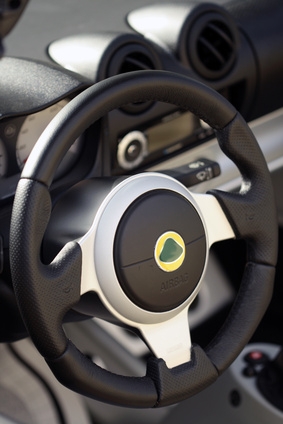
Wheels replaced lever steering devices on most cars in the late 1800s and have gone through a lot of incarnations over the past century. Control buttons have been added, odd shapes came into vogue and adjustable wheels---both for diameter size and tilt functions---were introduced. No matter the size, shape or material, steering wheels are used every time you drive, and they absorb a lot of wear and tear. Cracks develop, and other damage occurs. But you can repair your steering wheel with a few materials and a little elbow grease, returning even antique specimens to function and form.
Inspect the damage to determine what materials you'll need. Cracks in plastic and wood wheels can be filled and bonded with an epoxy such as PC 7. If damage is more extensive and you're repairing the wheel with restoration in mind, a product like POR-15 is a favorite among auto enthusiasts. It's water-based, and you can easily fill in defects and shape with a wet finger before the epoxy hardens, making sanding and shaping easier. Metal wheels may need to be "welded,"---especially if the integrity of the wheel's structure has been compromised--with something like JB Weld, an epoxy famous for its stronger-than-steel bonding properties.
Clean the wheel with soap and water to remove debris and grease. Let it dry.
Sand the area in and around the crack. Slide the sandpaper into the crack if it is wide enough and rough up any surface area that will require epoxy. Bevel the edges of the crack slightly.
Widen the crack with a hacksaw if the crack is deep. There is a steel skeleton inside the plastic or wood covering. If the crack runs to the metal and goes all the way around the wheel grip, enlarge it.
File the crack with a V-shaped file down to the steel core. You want to provide as much bonding surface between the two sides of the plastic or wood wheel as possible. You should be able to see the metal skeleton around the entire circumference of the crack.
Mix the epoxy according to the manufacturer's instructions. Wet your fingers slightly before kneading the putty. Roll the putty into a strip about 3 inches long---long enough to wrap around the wheel and fill the crack.
Wrap the epoxy around the wheel and gently work it into the crack, pushing it all the way to the metal core. Leave an amount of epoxy slightly higher than the surface of the wheel. Wet your fingers and spread the epoxy, feathering and smoothing it. Let the epoxy cure and harden according to instructions (usually at least a day).
Wet-sand the epoxy down to the wheel surface. Rinse, allow to dry and then use steel wool to finish. Paint the repaired area with a matching color.